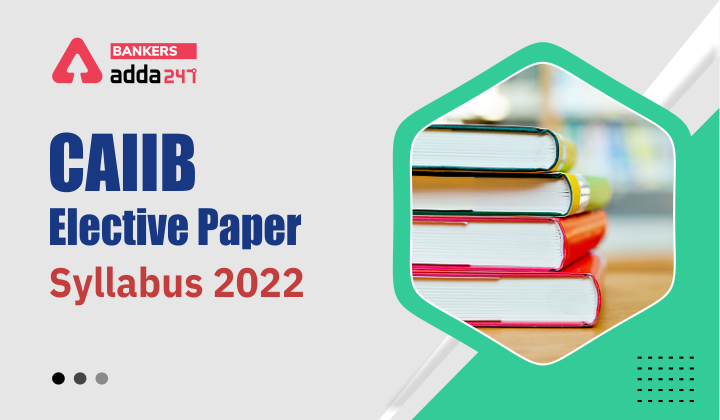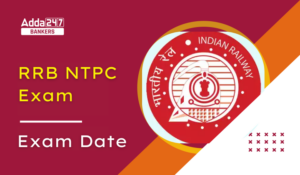Table of Contents
CAIIB Elective Paper Updated Syllabus 2022: CAIIB aims at providing advanced knowledge necessary for better decision-making covering Treasury Management, Risk Management, Balance Sheet Management, Credit Management, International Banking, Economic Analysis, etc. The Indian Institute of Banking & Finance(IIBF) has updated the CAIIB Elective Paper Syllabus and now the candidates have to prepare according to the updated syllabus. CAIIB Exam 2022 is scheduled to be held on 27th November,04th December, and 10th December 2022. In CAIIB Exam 2022 candidates have two compulsory paper and one elective paper. The Elective Paper should be chosen according to your interest so that it can fetch you the maximum score. In this article we have discussed the syllabus of all the elective papers in detail for the CAIIB Exam 2022 and have also provided the PDF of CAIIB Elective Paper.
Exam Pattern of CAIIB 2022
CAIIB(Certified Associate of Indian Institute of Bankers) is one of the flagship courses conducted by the IIBF (Indian Institute of Banking &Finance). IIBF provides the exam pattern for CAIIB Exam. The main highlights of the CAIIB Exam 2022 are given below:
- The CAIIB Exam 2022 will be conducted in Online Medium only.
- CAIIB Exam 2022 has three papers, two compulsory papers( Advanced Bank Management and Bank Financial Management) and one elective paper of the choice of candidate.
- Each of the three papers will be having 100 multiple choice questions of 100 marks.
- The time duration allotted to complete each paper will be 2 hours.
- The exam paper will be bilingual i.e. both in English and Hindi Language.
- There is no negative marking in the CAIIB Exam 2022
| Papers | Questions | Total Marks | Duration |
| Advanced Bank Management | 100 | 100 | 2 hours |
| Bank Financial Management | 100 | 100 | 2 hours |
| Elective Paper | 100 | 100 | 2 hours |
CAIIB Elective Paper Updated Syllabus 2022
CAIIB Exam 2022 also contains an elective paper and candidates must be acquainted with the updated syllabus of CAIIB Elective Paper. Candidates have to make their own choice among the different options available to them and choose one elective paper for the CAIIB Exam 2022. The different Elective Papers for the CAIIB Exam 2022 along with their modules are discussed here.
Elective Papers:
- Central Banking
- Rural Banking
- Retail Banking
- Human Resources Management
- Information Technology
- Risk Management
CAIIB Elective Paper 1 Syllabus 2022: Central Banking
Module A: Rationale and Functions of Central Bank
- Evolution and Functions of Central Banking: Evolution of Theory and Practice of Central Banking, Development of Central Banks in Developed and Developing countries.
- Functions of a Central Bank: Banker to Government, Banker to Banks, Monetary policy Functions, Currency Issue and Management, Payment system function, Maintaining Internal and External values of currency, Regulation, Facilitation, and supervision of Financial System, Promotional Functions to support growth and other National objectives, Development of Financial Markets, Institutions and communication policies.
- Contemporary Issues: Desirability, Autonomy, and independence, Credibility, accountability, and transparency of a Central Bank, conflict with fiscal policies.
Module B: Central Banking in India
- Reserve Bank of India: Organizational evolution, Constitution and Governance, Major organizational and Functional Developments over time, Recent Developments, RBI Act.
- India Specific Issues: Banking Regulation Act, FEMA, Banking Ombudsman Scheme, Financial Sector reforms, other financial regulators and division of functions.
- Institutions set up by RBI,NABARD, IDBI, DFHI, IRBI, UTI.
- Glossary of Central Banking Terms.
Module C: Monetary Policy and Credit Policy
- Monetary Policy: Objectives, Reconciling dual objectives, The Taylor Rule, Indicators of Policy, instruments of policy (Bank Rate, OMO, CRR, SLR, etc.), policy Transmission mechanism and channels, transparency of policies, Lags in the policy.
- Credit Policy: Objectives, Theory, and Practice, Instruments.
- An overview of Fiscal Policy: Importance of Budgets, Union Budget, State Budget, Finances of Union and State Governments, Finance Commission.
- Striking balance between inflation and growth through monetary and fiscal policies.
Module D: Supervision and Financial Stability
- Indian Financial System: Constituents of Indian Financial Markets and their Regulation. Evolution of Bank Regulation and supervision.
- Financial Stability: Financial Development Vs Financial stability, Risks to Financial stability, Early warning signals and remedial action, Liquidity Management, Regulation and supervision of Banks, Risk Management in Banks, The Basel Norms, Prudential Norms, Effect of liberalization and Globalization on Financial Stability, Linkage to International Financial Stability, International standards and codes. Role of Supervisor under Basel Norms.
CAIIB Elective Paper 2 Syllabus 2022: Rural Banking
The recent additions made by the IIBF in the Rural Banking Paper is provided here. Candidates who opt for Rural Banking Paper must click on the link and download the PDF for the complete information.
| Topic | Download PDF |
| RBI Notifications-July’21 to Dec’21 | Download Now |
| Rural Banking-Updates | Download Link |
| Rural Banking- Updates | Download Link |
| RBI Notifications-July’20 to Dec’20 | Download Link |
| RBI Notifications-Jan’20 to June’20 | Download Link |
| RBI Notifications-July’19 to Dec’19 | Download Link |
| RBI Notifications-Jan’19 to June’19 | Download Link |
The syllabus of all the four modules of Rural Banking along with their important topics are discussed below.
Module A: Rural India
- Demographic features: Population, occupation, literacy, socio-economic development indicators, health, nutrition, and education, – urban migration.
- Characteristics of Rural Society: Caste and power structure – rural social stratification, Economic Features: Economic life of rural people, share in National income -Trends in per capita income, rural money markets, rural indebtedness, rural poverty – main causes and methods of measuring rural poverty.
- Rural infrastructure: Transport, Power, Markets, and other services.
- Agriculture Economy: Structure and characteristics of Indian agriculture, Role of agriculture in economic development, agriculture-industry linkages, Resources and technical changes in agriculture, constraints to agriculture development, Emerging issues in Indian Agriculture.
- Rural Development Policy: Govt. policies and programs for rural farm and non-farm sectors. Economic reforms and their impact on the rural economy.
- Rural Issues: Development issues, Management Issues, Marketing issues, Pricing issues.
Module B: Financing Rural Development
- Regulation of Rural Financial Services – Function and policies of RBI in Rural Banking, NABARD Main functions, role, refinance support. Lead bank approach, State level, and District Level Credit committees.
- Rural Credit Institutions – Co-operative Credit Societies and Banks, Land Development Banks, Regional Rural Banks, Commercial Banks. Role of Information and communication technologies in rural Banking-Models, Financial inclusion & inclusive growth for rural development banking, rural insurance micro-insurance scheme, the concept of Business Facilitators and Business Correspondents in rural financing.
- Financing agriculture/ allied activities – Crop Loans Assessment, Sanction, Disbursement, replacement. Term loans for irrigation, farm mechanization, Godowns/ cold-storage facilities, etc. Financing allied agriculture activities like Horticulture, Fisheries, Social forestry, etc. Finance against Warehouse/ cold storage receipts.
- Financing Rural Non-Farm Sector (RNFS) – Importance of RNFS, Segments in RNFS, Role of Development and Promotional Institutions in RNFS SME Finance, Definition of SME. Importance to the Indian economy.
- Financing of SME and small enterprise Refinance from SIDBI – Project funding techniques and requirement assessment. Cluster-based approach and joint finance with SIDBI. MSMED Act 2006, CGTMSE, Working capital assessment of SMEs. Risk rating of SME proposals, the role of rating agencies, and rating methodology. Revival of sick units; revival package and implementation, Stressed assets under rehabilitation. Debt restructuring mechanism for SMEs.
Module C: Priority Sector Financing and Government initiatives
- Components of priority sector – RBI guidelines. Government initiatives; Poverty alleviation programs/ Employment programs/ Production oriented programs – rationale and philosophy, progress and impact, problems and deficiencies.
- Rural housing and Urban housing schemes under priority sector – there refinance, Educational loans.
Module D: Problems and prospects in Rural Banking
- Role of rural banking – Problems of Rural branches of Commercial banks – transaction costs and risk costs.
- Technology-based Financial Inclusion – Emerging trends in rural banking-financing poor as a bankable opportunity, Micro Credit, Self Help Groups/ NGOs, linkages with banking, latest guidelines of GOI and RBI.
CAIIB Elective Paper 3 Syllabus 2022: Retail Banking
Retail Banking is one of the most important and scoring elective paper. Most number of candidates choose Retail Banking as their elective paper. To score high in the Retail Banking paper aspirants must know the complete syllabus of Retail Banking. IIBF has made some changes in the Retail Banking Paper and in the table below we have listed the PDF.
| Topic | Download PDF |
| RBI Notifications-Jul’21 to Dec’21 | Download Link |
| Subject Updates-January to June 2021 | Download Link |
| RBI Notifications-July’20 to Dec’20 | Download Link |
| RBI Notifications-Jan’20 to June’20 | Download Link |
| RBI Notifications-July’19 to Dec’19 | Download Link |
| RBI Notifications-Jan’19 to June’19 | Download Link |
| Retail Banking-Updates | Download Link |
| PMLR Amendment Highlights | Download Link |
| PMLR Amendment Gazette | Download Link |
The topics that an aspirant has to cover in all the modules of Retail Banking is summed up here:
Module A: Introduction
History and definition, role within the bank operations, Applicability of retailing concepts distinction between Retail and Corporate/ Wholesale Banking.
Module B: Retail Products
- Retail Products Overview – Customer requirements, Products development process, Liabilities and Assets Products/ Description of Liability products, Description of Asset Products, the Approval process for retail loans, credit scoring.
- Important Asset Products – Home Loans – Eligibility, Purpose, Amounts, Margin, Security, Disbursement, Moratorium, Prepayment issues, Repayments/ Collection.
- Auto/ Vehicle Loans – Eligibility, Purpose, Amounts, Margin, Security, Disbursement, Moratorium, Prepayment issues, Repayments/ Collection.
- Personal Loans – Eligibility, Purpose, Amounts, Security, Disbursement, Moratorium, Prepayment issues, Repayments/ Collection, Educational Loans Eligibility, Purpose, Amounts, Security, Disbursement, Moratorium, Prepayment issues, Repayments.
- Credit/ Debit Cards – Credit Vs Debit Cards, Eligibility, Purpose, Amounts, Margin, Security, Process of using the cards, Billing Cycle, Credit Points, Other Products/ Remittances/ Funds Transfer.
Module C: Marketing/ Selling of retail products, MIS and Accounting
- Retail Strategies – Tie-up with Institutions for Personal loans/ Credit cards/ Educational loans, with OEMs/ Authorized Dealers for Auto/ Vehicle loans, and with Builders/ Developers for Home loans
- Delivery Channels – Branch, Extension counters, ATMs, POS, Internet Banking, M-Banking.
- Selling Process in retail products – Direct Selling Agents.
- Customer Relationship Management – Role and impact of customer relationship management, Stages in customer relationship management process.
- Regulations and compliance Technology for Retail Banking – Static information, Account opening, basic loan origination data, etc. The updated information like income details at different frequencies. Transaction information from disbursement till final settlement of the loan amount. Analytics/ Alerts.
- Accounting entries – Loan process and the relevant accounting including EMI Computation.
Module D: Other issues related to Retail Banking
- Securitization, mortgage-based securities.
- Trends in retailing – New products like Insurance, Demat services, online/ Phone Banking, Property services, Investment advisory/ Wealth management.
- Reverse Mortgage – Growth of e-banking, Cross-selling opportunities.
- Recovery of Retail Loans – Defaults, Rescheduling, recovery process. SARAFAESI Act, DRT Act, use of Lok Adalat forum. Recovery Agents – RBI guidelines.
- New products like Insurance – Demat services, online/ Phone Banking, Property services, Investment advisory/ Wealth management.
CAIIB Elective Paper Syllabus: Download PDF
CAIIB Elective Paper 4 Syllabus 2022: Human Resource Management
Module A: Human Resources Management
- Concepts, Policies, and Practices: Fundamentals of HRM; Importance of Human Capital, Management of transformation, New insights into HR Management and contemporary issues, Relationship between HRM and HRD; Structure and Functions, Policies and Practices, Role of HRD professional, Development of HRM in India.
- Behavioral Dynamics in organizations: Person – Job Fit, Group Dynamics, Group Problem Solving and effectiveness, Leadership and Teambuilding, Change Management, Human Response – Implications of benchmarking; TQM, BPR, ISO 9000 Series and other techniques for Organizational Improvement and Management of Service Industry; Quality Circles. Six Sigma and its implication in organizational development.
- Organizational Change and Development: Responsibility Charting, Conditions for Optimal Success, Role of Change Agent and Managing Change.
- HRM in Banks: Traditional Role of Human Resources Department in Banks, Expectations from HR Department, Conflict of new initiatives with work culture and capacity, Major HRM challenges facing Banks, Core Banking and HR challenges,
- Knowledge management in Banks: Need for Knowledge Management Officer, Role in the Banks, HRM and Information Technology, Information and Database Management, Preparation and updation of Manuals and job cards, Linkage with Educational Institutions.
Module B: Building an HR strategy
- Strategy Formulation and implementation: Need for a distinctive HR strategy, Formulating the strategy; a connecting strategy to the organization, aligning HR Systems with decision framework, Relationship between Sustainable strategic success and performance of the organization, Execution of strategy: Role of CEO, Executive Team, and line Managers, Succession Planning, HRD Audit, Effectiveness of HRD, Best HR practices in banks.
- Organizational Communication: Barriers to Communications, Steps for effective communication in the organization
- Manpower Planning: Recruitment, Selection, Placement, and Promotion. Recruitment Vs Outsourcing: Concept and Feasibility of Outsourcing, advantages, disadvantages, and constraints, Compensation; incentive system linked to productivity, dealing with attrition.
- Performance Management and Appraisal Systems: Performance Appraisal System, Role of PAS, Emerging Trends, 360-degree performance Appraisal, Appraisal Vs Feedback, Competency Mapping, Key Performance Areas (KPA).
Module C: Motivation, Training and Skill Development
- Human implications of Organizations; Learning and instructions, Learning Processes, Employee Behavior, Theories of Motivation and their practical implications, Motivational strategies, Reward and Incentive schemes, job enrichment, job rotation. Employee development strategies and Techniques.
- Training and Development; Attitude development, Role and impact of training, Career Path Planning and Counseling, Changing face of Banking, Future of Bank Education, Identification of Training Needs.
- Training Methodology; subject matters of Training, Training infrastructure in Banks, outsourcing of Training, On – the job training, Management of conflict between Training and operations due to manpower constraints, Development of soft skills and communications. Developing competencies through e-learning, virtual learning, and self-directed learning. Training measurement and impact.
Module D: Personnel Management and Industrial Relations
- The personnel functions; Legal aspects of personnel functions, trade unionism, and Industrial Relations; Industrial Relations and Negotiations in the Indian Banking Industry, Collective Bargaining Concepts; Bipartite Settlements in Banking, Employee Welfare; Policies and Schemes.
- Grievance Redressal and Discipline; Mechanism and Processes, Discipline Management including Domestic Enquiry, Role of Management and Functions, Conflict Management and Resolution, Frauds in Banks, Risks attached to Delegation of Financial Powers; Precautions and Controls, need for a vigilance Department in Bank, Diversity and Gender Issues, Dealing with the cases of Sexual harassment.
- Workers’ Participation in Management, Experience of Employee Participation in the Indian banking industry.
CAIIB Elective Paper 5 Syllabus 2022: Information Technology
The Indian Institute of Banking and Finance(IIBF) has updated some of the topics of Information Technology(IT). The updated syllabus has to be covered for the upcoming CAIIB Exam 2022. To know the complete detail about the updated topics aspirants click on link given below and download the PDF.
| Topics | Download PDF |
| RBI Notifications- July’21 to Dec’21 | Download Link |
| Subject Updates-January to June 2021 | Download Link |
| RBI Notifications-July’19 to Dec’19 | Download Link |
| Information Technology Updates | Download Link |
All the modules and their topics are listed below to help the candidates in their preparation. Aspirants who have opted for the IT Paper must go through the complete syllabus of IT.
Module A: Introduction to Information Technology
- Impact of IT on Banking: Changing Financial Environment and IT as a Strategic Response. Hardware (H/ W) – Software: (S/ W)
- System Software: Operating Systems (Desktop OS/ Server OS) Windows (Desktop/ Server)/ UNIX (H. P. Unix, Sun Solaris, Linux, IBMAIX). Computer Languages – 1st Generation Languages (Assembly), 2nd Generation (FORTRAN, ALGOL, COBOL), 3rd Generation (C, C++, C# and JAVA, etc.) and 4th Generation Languages (Clipper, Power Builder, SQL, etc.) and 5th Generation Languages (Logic Programming Languages) Database Management System and Relational Database Management Systems (Oracle10g, MS SQL-2005, MySQL) Application Servers (Oracle 10AS, Be Web logic, Web Share ) Web Servers (IIS, Apache, etc.) Web Browsers (IE 7.0, Firefox, etc.)
- Application Software: Packaged Software, Custom-built Software, etc. Computer Networks.
- Equipment and Data Communication: Computer Networks: Network Layers, Topologies, Protocols, IP Address Mechanisms, LAN, WAN, VLAN, Intranet, Extranet, Internet.
- Network Equipment: Cables (BNC, Twisted Pair, Fibre Optics), Connectors, I/Os, Patch Panel, Jack Panels, Network Racks.
- Data Communication: CLL, Leased Lines, MPLS, VPNS, ISDN, Satellite Links, WiFi, Wi-Max.
- Network/ Security Equipment: Modems, Hubs, Switches, Bridges, Routers, Firewalls, NIDS, HIDS, IPS.
Module B: System and Design
- Systems Design and Analysis Data modeling – Entity Relationships, Generic Data Modeling, Semantic Data Modeling Normalization (from 1st to 3rd and BCNF, 4th & 5th level of normalization).
- Software Development Life Cycle (SDLC) – Various phases of SDLC, In-house/ Out-sourcing, Software Project Management, Computer-Aided Software Engineering (CASE) Tools.
- System Architecture – Clients (Hardware/ Software), Servers (Hardware/ Software). Client-Server Architecture, 3 Tier Architecture, N-Tier Architecture, etc.
- Data Warehousing – Data Mining tools MIS and Organization Support Systems, DSS, EIS, GDSS, Groupware, and Multimedia.
- Business Intelligence – Expert Systems, Artificial Neural Networks (ANN) Grid Computing, Virtualization, and Consolidation.
Module C – Application in Banking
- Centralized Banking System – Core Banking System/ System Administration, Database Administration, Application Server, and Application Administration, Network Administration, Domains, ISPS, Hosting, Data Downloads/ Uploads, Bandwidths, Data Centre, Data Storage Devices, Data Backups/ Restoration, Disaster Recovery Centre
- Delivery Channels – ATM, EFTPOS, Phone Banking, Internet Banking, SMS Banking, Mobile Banking, Credit/ Debit Cards, Smart Cards E-Mails, SMS alerts.
- E-Commerce – Secure Electronic Transfer (SET), Payment Gateways (Credit card/ Debit cards), Authentication of payments, etc.
- PKI – CCA, CA, RA, Digital Certificate, Digital Signature, Non-repudiation of Origin, Nonrepudiation of Receipt. Service – Level Agreement
Module D: Security, Control and Guidelines
- Threats to Information System: a) Physical (Insiders/ outsiders) b) Viruses, Worms, Trojan horse, Malware, Software bombs, Phishing, Spoofing, Spamming, denial of service attacks, etc. Information System Security Measures, Policy, controls, ISO, 17799, BS7799, IS4477, IS Audit, BCP/ DRP, IT Act 2000, Basel guidelines for E-banking, Various RBI Committee Reports on Information Systems.
- IT Service Delivery and Support: Service level management practices, Operations management – workload scheduling, network services management, Preventive maintenance, Systems performance monitoring process tools, techniques, Functionality of hardware, software, database. Drafting of RFP, system specifications, SLAs, Capacity planning & monitoring, Change management processes/ scheduled, emergency in the configuration of production systems, application of patches, releases, etc., Incident & problem management practices, System resiliency tools and techniques – fault tolerance, elimination of single point of failure, clustering
CAIIB Elective Paper 6 Syllabus 2022- Risk Management
The topics that are updated along with their PDF are mentioned below. Aspirants who opt for the Risk Management Paper can download the PDF and get all the required details for their preparation.
| Topics | Download PDF |
| RBI Notifications-Jul’21 to Dec’21 | Download Link |
| Subject Updates-January to June 2021 | Download Link |
| RBI Notifications- Jul’20 to Dec’20 | Download Link |
| RBI Notifications- Jan’20 to Jun’20 | Download Link |
| RBI Notifications-Jul’19 to Dec’19 | Download Link |
| RBI Notifications- Jan’19 to Jun’19 | Download Link |
| Financial Benchmark Administrators Directions, 2019 | Download Link |
| Vertical and Horizontal Disallowance in Market Risk | Download Link |
| Additional Reading Material for Risk Management | Download Link |
| Large Exposures Framework | Download Link |
| Risk Management Information Security | Download Link |
| Liquidity Risk | Download Link |
| Enterprise Wide Risk Management | Download Link |
| Partial Credit Enhancement | Download Link |
| Corrigendum-Risk Management | Download link |
The modules of Risk Management and their important topics that are to be covered for the CAIIB Exam 2022 are listed below.
Module A: An overview
1) Risk definition/ policies
- Risk Process-Risk Organization
- Key risks – Credit risk, market risk, operational risk, liquidity risk, legal risk, interest rate risk and currency risk.
2) Asset Liability Management
a) ALM Concept
b) ALM organization
c) ALCO techniques/ tools
d) Simulation, Gap, Duration analysis, Linear and other statistical methods of control
3) Risk measurement & Control
a) Calculation
b) Risk exposure analysis
c) Risk management/ mitigation policy
d) Risk immunization policy/ strategy for fixing exposure limits
e) Risk management policy and procedure
f) Risk-adjusted return on capital
g) Capital adequacy norms
4) Risk management
a) Capital adequacy norms
b) Prudential norms
c) Exposure norms
d) Concept of Mid office
e) Forwards
f) Futures
g) Options
h) Strategies and Arbitrage opportunities
i) Regulatory prescriptions of risk management
Module – B: Credit Risk Management
a) Introduction
b) Basel Norms
c)Three pillars of Basel and Capital for Operational risk
d)Framework for risk management
e)RBI guidelines on risk management
f) Risk rating and risk pricing
g)Methods for estimating capital requirements
h) Credit risk – standardized approach
i) Credit risk – an advanced approach
j)Credit rating/ credit scoring and rating system design
k) Credit Bureaus
l)Stress test and sensitivity analysis
m) Internal Capital Adequacy Assessment Process (ICAAP)
n) Introduction to structured products
Module – C: Operational Risk
- Introduction, Basel Norms
- RBI guidelines
- Likely forms of operational risk and causes for a significant increase in operational risk
- Sound Principles of Operational Risk Management (SPOR)
- SPOR – organizational setup and key responsibilities of ORM
- SPOR – policy requirements and strategic approach for ORM
- SPOR identification, measurement, control/ mitigation of operational risks
- Capital allocation for operational risk, methodology, qualifying criteria for banks for the adoption of the methods
- Computation of capital charge for operational risk
Module – D: Market risk
1) Introduction and definition
2) Prescriptions of Basel Norms
3) Liquidity risk
4) Interest rate risk
5) foreign exchange risk
6) Price risk (Equity)
7) Commodity risk
8) Treatment of market risk under Basel
a) Standardized duration method
b) Internal measurement approach
Module – E: Risk Organization and Policy
a) Risk Management Policy
b) Interlinkages to – Treasury
c) Credit
d) ALCO
Related Posts:
| CAIIB November Exam Date 2022 Out | JAIIB CAIIB Mahapack |
| CAIIB Syllabus 2022 |
CAIIB ABM Syllabus 2022 |
| CAIIB BFM Syllabus 2022 |
FAQs: CAIIB Elective Paper Syllabus 2022
Q.1 How many elective papers are there for CAIIB Exam 2022?
Ans. There are 6 Elective Papers for CAIIB Exam 2022.
Q.2 Where can we get the detailed syllabus of Elective Papers for CAIIB Exam 2022?
Ans. The detailed syllabus of Elective Papers for CAIIB Exam 2022 is discussed above.






 GA Capsule for SBI Clerk Mains 2025, Dow...
GA Capsule for SBI Clerk Mains 2025, Dow...
 The Hindu Review October 2022: Download ...
The Hindu Review October 2022: Download ...
 RRB NTPC Exam Date 2025 Soon, Check Expe...
RRB NTPC Exam Date 2025 Soon, Check Expe...





